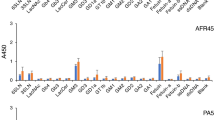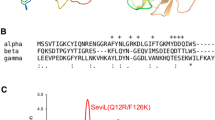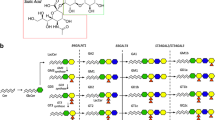Abstract
RECENT evidence suggests that the antiviral action of interferon is triggered by interaction with the cellular membrane. Mouse interferon covalently bound to Sepharose beads (IF-Sepharose) retains its antiviral potency and only direct contact with these particles produces the antiviral effect1,2. Preincubation of mouse L cells with Phaseolus vulgaris phytohaemagglutinin (PHA) blocks interferon action3. The inhibitory action of PHA can be almost completely reversed by washing PHA-treated cells with fetuin, a glycoprotein of high affinity for this plant lectin3. These data suggest that membrane sites interacting with interferon are carbohydrate-containing molecules that bind to PHA, although other explanations for the inhibitory action of PHA based on nonspecific steric or charge effects might be possible. To substantiate further that glycoside-containing membrane components bind to interferon, we have investigated the effect of gangliosides on interferon binding and action.
This is a preview of subscription content, access via your institution
Access options
Subscribe to this journal
Receive 51 print issues and online access
$199.00 per year
only $3.90 per issue
Buy this article
- Purchase on Springer Link
- Instant access to full article PDF
Prices may be subject to local taxes which are calculated during checkout
Similar content being viewed by others
References
Ankel, H., Chany, C., Galliot, B., Chevalier, M. J., and Robert, M., Proc. natn. Acad. Sci. U.S.A., 70, 2360–2363 (1973).
Chany, C., Ankel, H., Galliot, B., Chevalier, M. J., and Gregoire, A., Proc. Soc. exp. Biol. Med. (in the press).
Besançon, F., and Ankel, H., Nature, 250, 782–785 (1974).
Svennerholm, L., Biochim. biophys. Acta, 24, 604–611 (1957).
Cuatrecasas, P., Biochemistry, 12, 3558–3566 (1973).
Van Heyningen, W. E., Nature, 249, 415–417 (1974).
Cuatrecasas, P., Biochemistry, 12, 4253–4264 (1973).
Weinstein, D. B., and Marsh, J. B., J. biol. Chem., 245, 3928–3937 (1970).
Haywood, A. M., J. molec. Biol., 83, 427–436 (1974).
Craighead, J. E., and Shelokov, A., Proc. Soc. exp. Biol. Med., 108, 823–286 (1961).
Svennerholm, L., J. Neurochem., 10, 613–623 (1963).
Chany, C., and Vignal, M., C. r. hebd. Séanc. Acad. Sci., Paris, 267, 1798–1800 (1968).
Lowry, O. H., Rosebrough, N. J., Farr, A. L., and Randall, R. J., J. biol. Chem., 193, 265–275 (1951).
Sica, V., Parikh, I., Nola, E., Puca, G. A., and Cuatrecasas, P., J. biol. Chem., 248, 6543–6558 (1973).
Dubois, M., Gilles, K. A., Hamilton, J. R., Rebers, P. A., and Smith, F., Anal. Chem., 28, 350–356 (1956).
Author information
Authors and Affiliations
Rights and permissions
About this article
Cite this article
BESANCON, F., ANKEL, H. Binding of interferon to gangliosides. Nature 252, 478–480 (1974). https://doi.org/10.1038/252478a0
Received:
Revised:
Issue Date:
DOI: https://doi.org/10.1038/252478a0
This article is cited by
-
Gangliosides, copper ions and angiogenic capacity of adult tissues
CANCER AND METASTASIS REVIEW (1990)
-
Interferon receptors
In Vitro Cellular & Developmental Biology (1988)
-
Detection of femtomolar quantities of the ganglioside GM1 on thin-layer chromatography plates by native choleratoxin and labeled antisera
Current Microbiology (1986)
Comments
By submitting a comment you agree to abide by our Terms and Community Guidelines. If you find something abusive or that does not comply with our terms or guidelines please flag it as inappropriate.



